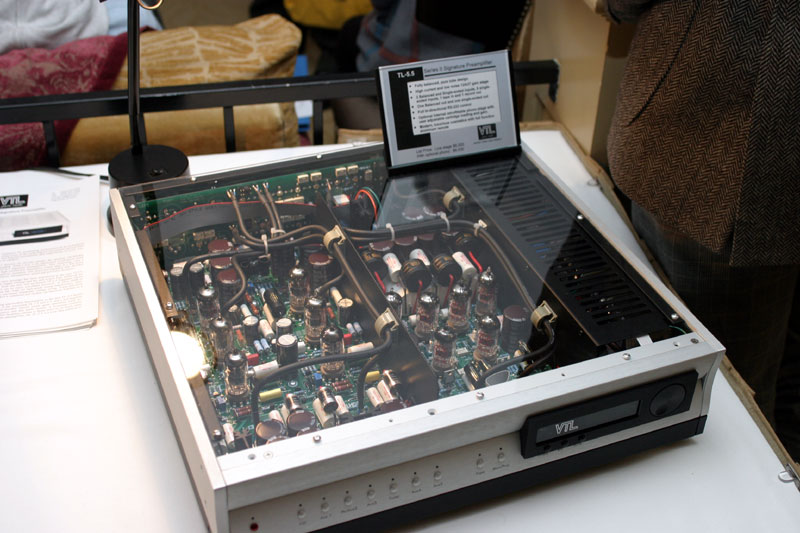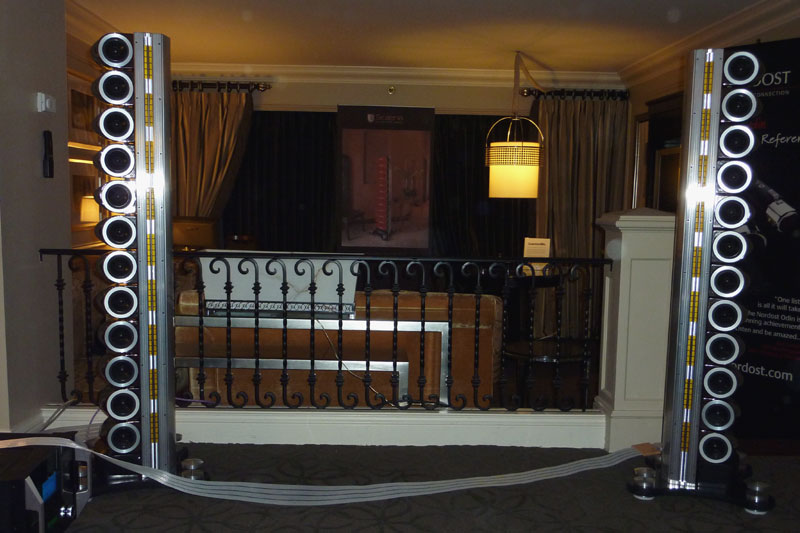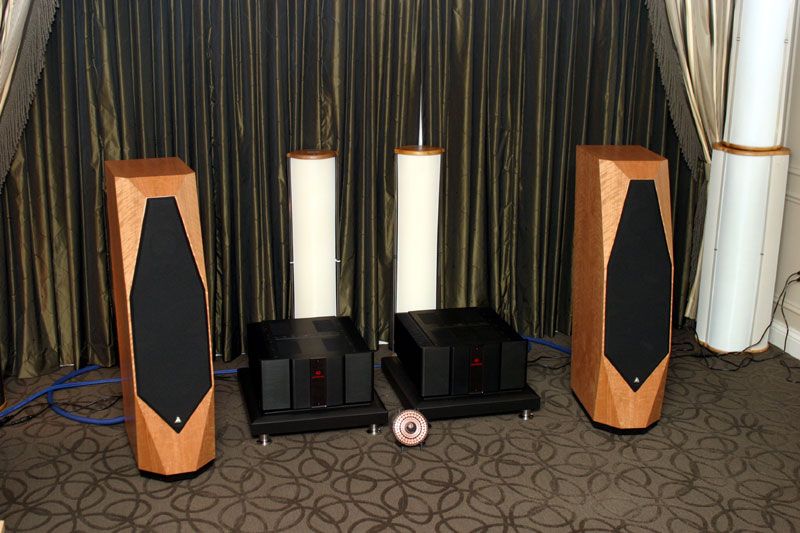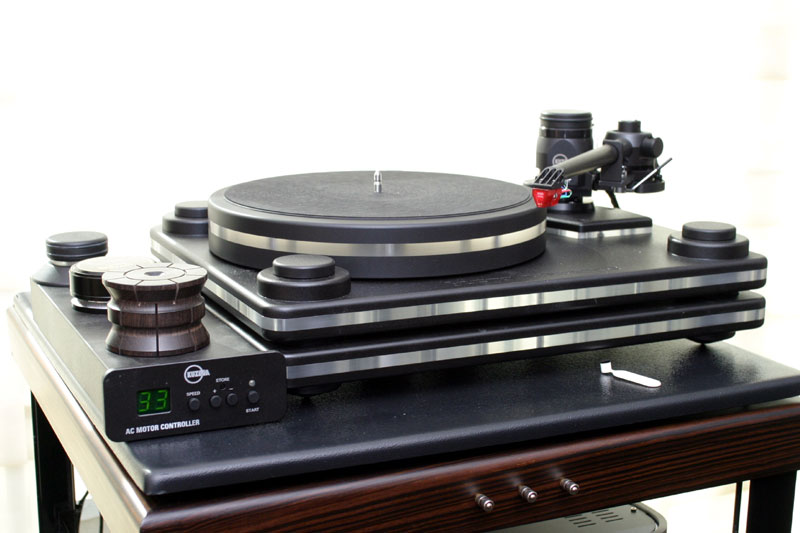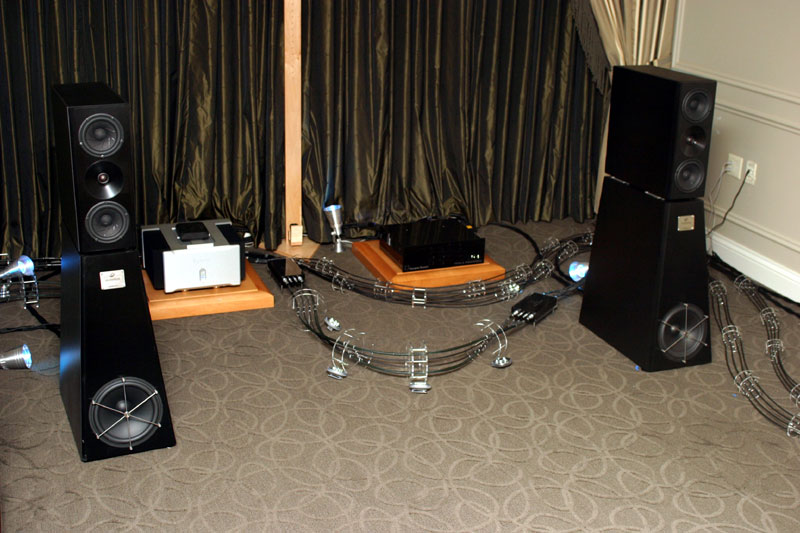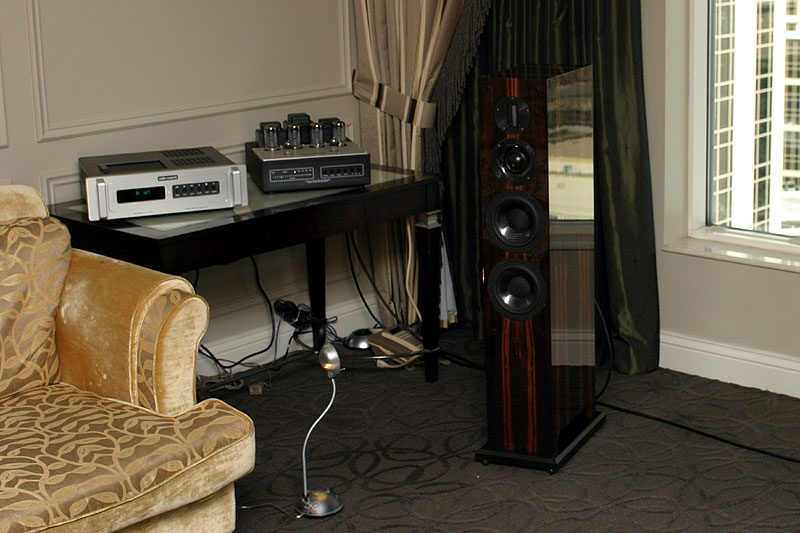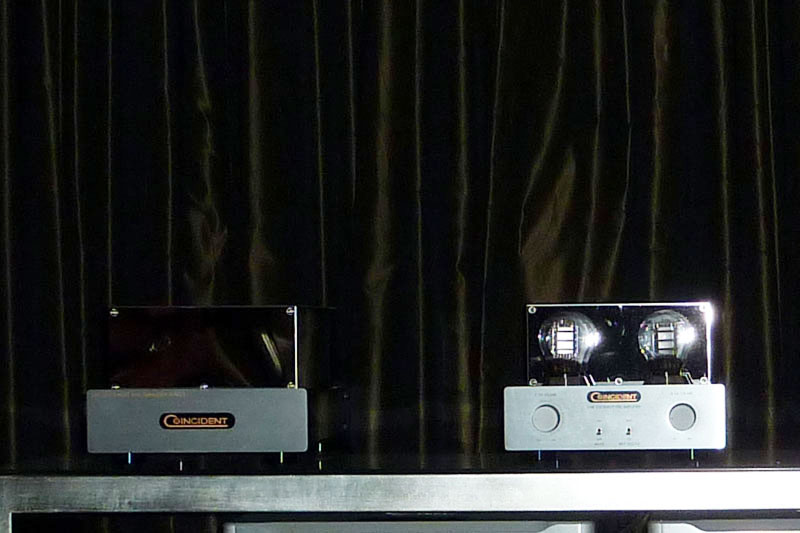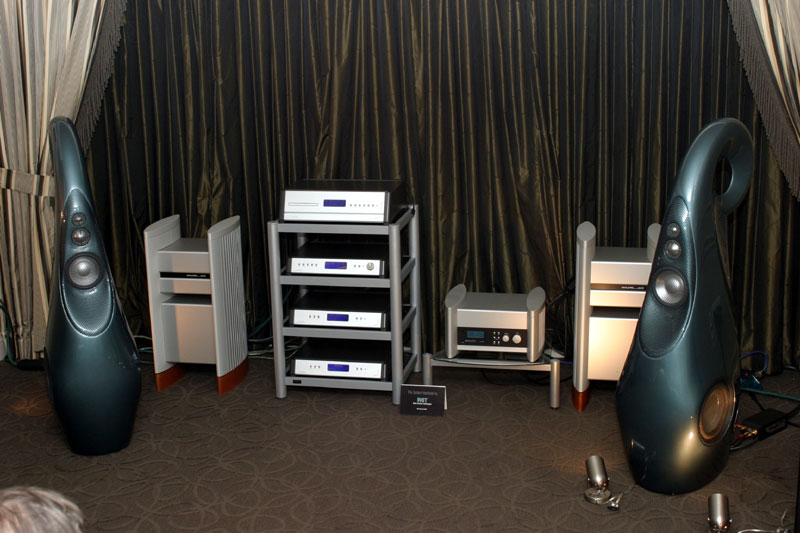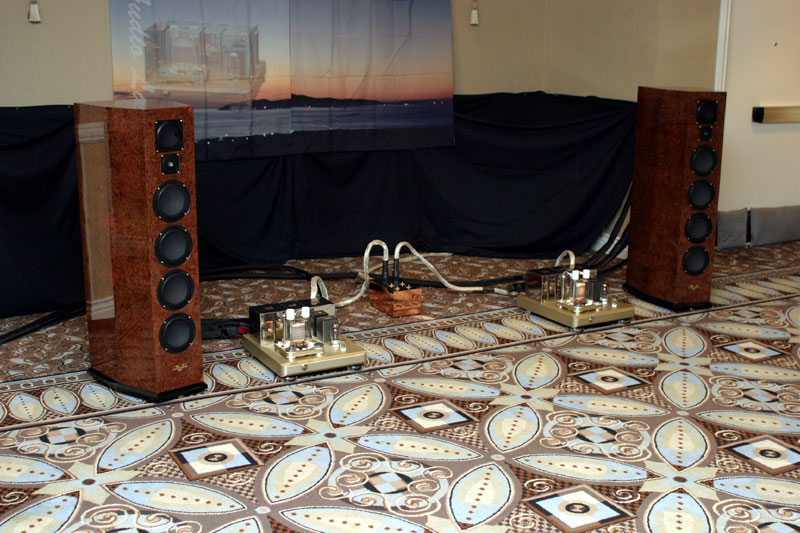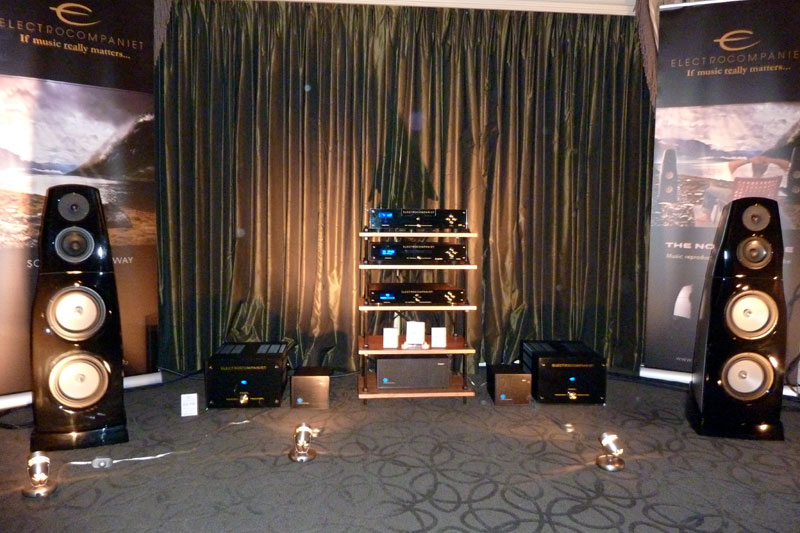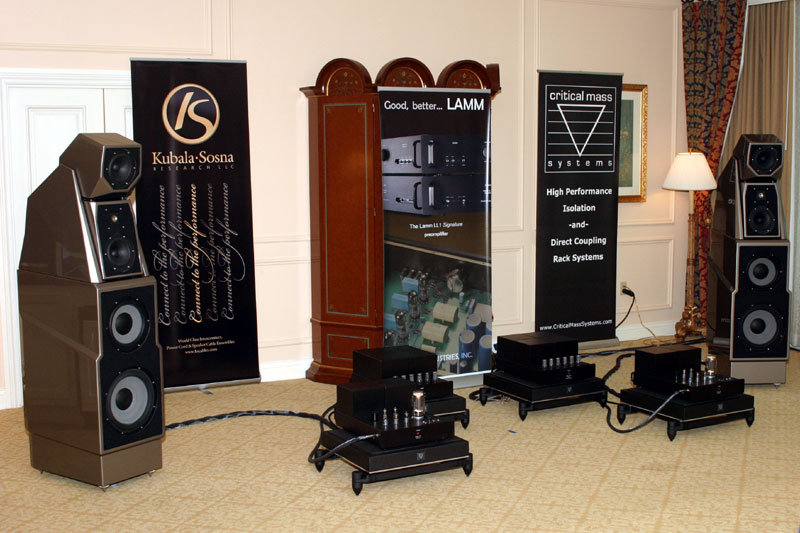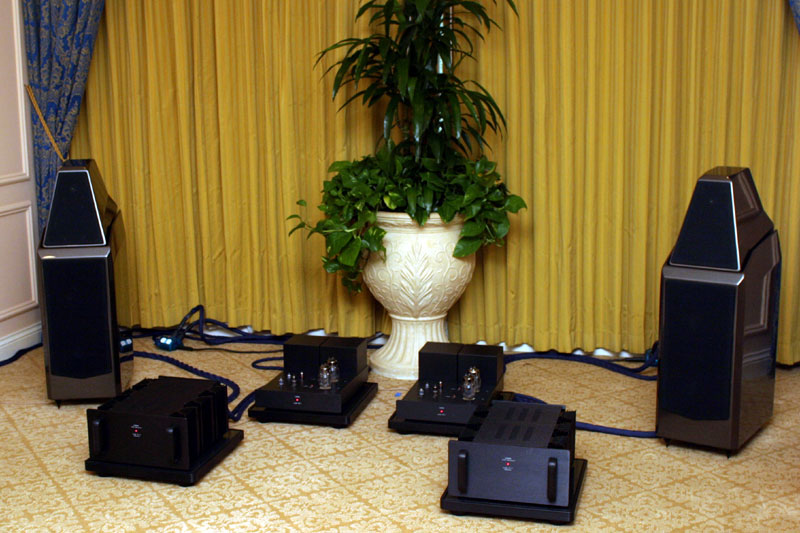CES & THE Show 2010 • American Sonic Splendor
This year’s Consumer Electronics Show marked my first visit to the annual conclave since 2005. While some exhibitors staked out rooms at the Mirage across the street from high-end audio’s headquarters at the enormous and palatial Venetian complex, having the lion’s share of the show under one roof made getting around easier than at my last visit, where the Alexis Park served as the principal redoubt of perfectionist audio. A couple of blocks south on Las Vegas Blvd., THE Show held forth at the Flamingo Hotel. As there was so much to see and hear at the Venetian, I concentrated my efforts there. Two seemingly mutually contradictory developments stood out for me. Both turntables and computer-based digital systems were thick on the ground. The former were relatively rare the last time I visited CES and the latter were unheard of. Much to my surprise, there was a considerable amount of good sound to be heard from many of the laptop-based playback rigs, which were inevitably connected to more "proper" components via USB cables. Time, it appears, is marching on. One thing has not changed, and that is the fact that it is impossible to hear all there is to hear, even in four days. Room to room
Kicking off my show was a visit to the Audio Research room, where the new DS450 power amplifier ($7995) was displayed with a suite of Reference-series stablemates and Sonus Faber Cremona Elipsa loudspeakers ($20,000/pair). Cabling was provided by Shunyata Research and stands by Harmonic Resolution Systems. The DS450 delivers 450wpc into an 8-ohm load and is based on circuitry developed for ARC’s DSi200 integrated amplifier. The sound was typical for Audio Research: dynamic, spacious and full-blooded.
VTL brought the TL-5.5 Series II line stage ($6000), which is also available as a full-function preamplifier (above, $8000) with quite a fine internal phono stage. Also on display were the TL-7.5 Series II line stage ($18,500) in tandem with the TP-6.5 Signature phono stage ($8500). Analog sounds were provided by a Spiral Groove SG2 turntable, Tri-Planar Mk VII UII 'arm and Lyra Skala cartridge. Playing through the 600W Siegfried monoblocks ($50,000/pair) and TAD’s extremely impressive Reference One loudspeakers ($60,000/pair), both front-ends showed VTL’s traditional combination of refinement and muscle-power to fine effect with several of my favorite recordings.
Scaena loudspeakers look nothing like anything else to be found anywhere and are capable of doing things few speakers can, based on my hearing at the show. Paired with dCS’s complete Scarlatti digital front-end (some $75,000) running directly into a massive pair of McIntosh MC 2301 tube amplifiers ($22,000/pair), the Scaenas are available with 12, 15 or 18 dynamic drivers per tower (as well as a proportionate number of ribbon tweeters) and up to three subwoofers per channel. The 12-driver version seen at CES comes with a pair of subwoofers, which include crossover, digital signal processing and amplification, and lists at $54,000. The Scaenas threw what seemed to be a plasma field of utterly solid and believable sound into the room, life-sized and timbrally true. Admittedly, the source material was as good as it gets -- an SACD of Kind of Blue. This demo left me somewhat agog. Would that I had a big enough room to accommodate a set of these remarkable speakers. Ray Kimber’s room is always a place to hear superb recordings, and CES was no exception. EMM Labs showed the XDS1 CD/SACD player ($24,995), with some of Kimber’s recent recordings. The real surprise here was the Sony SS-AR1 speaker (approximately $20,000/pair) making such dynamic and silkily sophisticated sounds. Sadly, the SS-AR1 is not yet available in the US, but this is a speaker that could definitely make some waves on this side of the Pacific if Sony decides to bring it over. Sumiko showed Sonus Faber’s Stradivari Homage speakers ($45,000/pair) (accompanied a bit enthusiastically at times by no less than six REL G-1 subwoofers) with a full complement of the latest Audio Research Reference-series electronics, including the imposing Reference 610T monoblocks ($39,900/pair). A special attraction here was the display of Sonus Faber speakers through the years. Has any company ever built more consistently beautiful loudspeakers? There truly is something special about Italian design aesthetics.
Karan Acoustics was a new name to me, but one that is well-established in Europe. Based in Serbia, Milan Karan now sends his equipment to North America via West Side Music of Calgary, Alberta, Canada. Paired with a Zanden Audio Model 2500 CD player ($21,000) and Avalon’s head-turning new Time loudspeaker ($48,000/pair), Karan’s Mk II line stage ($17,500) and massively powerful KA M 1200 monoblocks ($57,500/pair) produced lovely, refined sound that had naturally scaled dynamics and enticing sweetness. I think a detailed follow-up is called for, as this was one of my finalists for best-sound honors. Speaking of sweet solid-state sound, Pass Labs displayed its full range of electronics, with the XP-20 preamp ($8600), XP-25 phono stage ($10,600), and XA100.5 monoblocks ($16,500/pair) driving the all-new SR-2 loudspeakers ($18,500/pair in standard finish). Relaxing and resolving were the watchwords for this system.
Elite Audio/Video Distribution’s room was packed with a large static display of Furutech's cable and power products as well as a versatile, dynamic system of Plinius electronics, Kuzma’s Stabi Reference ‘table ($8900) and 4-Point NSE 'arm ($5950), and Reference 3A’s always-pleasing Grand Veena loudspeakers ($7995/pair). Marc Mickelson’s glowing reviews of various Zanden Audio components piqued my interest in this artisanal Japanese gear, and my curiosity was rewarded in a big way. The new Model 1200 Mk 3 phono stage ($25,000), Model 3000 preamplifier ($17,250) and Model 9600 tube monoblocks ($51,975 each) made beautiful music, with Grand Prix Audio’s sexy, ultra-high-tech Monaco turntable ($20,000) spinning the LPs and Zanden’s own Model 2000P CD transport and Model 5000S DAC handling the CDs. It is entirely possible that the Wilson Audio Sasha W/P speakers ($26,950/pair) at the system’s business end might also have had something to do with the gorgeous sounds coming out of this system.
The Synergistic Research room fascinated on several levels. The front-end consisted of Esoteric's P-03 transport ($16,500), D-03 digital-to-analog converter ($16,500), G-0Rb rubidium (atomic) master clock ($18,500), C-03 line stage ($12,000) and A-03 stereo amplifier ($14,000). As at the Rocky Mountain Audio Fest, everything was hooked up with Synergistic's bogglingly costly, actively shielded Galileo interconnects ($25,000/pair) and speaker cables ($40,000/pair), and the room was sprinkled with Acoustic Arts resonator room treatments. YG Acoustics Anat Reference II Studio loudspeakers ($70,000/pair) completed what Synergistic's Ted Denny stated was "basically my home system." YG Acoustics speakers did nothing for me at the Rocky Mountain Audio Fest, but here there was a sweetly refined delicacy, tremendous focus, and spacious and seductive bloom and expansiveness. Simply put, this was a marvelous-sounding system that spoke very well not only for the YG speakers but for everything in front of them.
ProAc provided me with a more-than-pleasant surprise. The new Carbon Pro Six floorstander ($30,000/pair) featured carbon-fiber drivers in a drop-dead-gorgeous macassar ebony cabinet that sits atop a carbon-fiber plinth. Audio Research’s Reference CD8 CD player ($9995) and VSi55 integrated amplifier ($3995) showed the Six to have uncanny musical naturalness in a plain, untreated room. I’ve heard and liked a number of ProAc speakers over my years in the audio biz, and the Carbon Pro Six only adds to their number. Another notable debut was Nola’s Metro Grand Reference speaker ($22,000/pair), filling the gap between the stand-mounted Mini Grand Reference and the Baby Grand Reference. The room at CES was a bit cramped compared to the one at the Rocky Mountain Audio Fest, but the Metro showed itself to have all of the myriad virtues of its siblings. As was the case in Denver, Audio Research Reference electronics and Nordost wiring were present and well accounted for. Legacy Audio brought a new version of the well-regarded (by me, anyway) Whisper loudspeaker, the XD ($19,995/pair). Unlike previous iterations of the Whisper, the XD incorporates an integral 500W amp and digital signal processing to optimize the performance of each tower’s four open-mounted woofers. The mids and tweeters were driven by a luscious-sounding Ayon CD-07 digital player ($2800) and Triton 125Wpc integrated amplifier ($8450), and the sound was big, bold and thoroughly involving. I have always found that Legacy offers an enormous amount of performance per dollar. The Whisper XD and the Electrocompaniet Nordic Tone 1 (discussed below) are the only sub-$40,000 speakers I've heard that might challenge the all-conquering Wilson Audio Sasha W/P, my review of which was published after I returned from CES.
Coincident Speaker Technology’s Israel Blume has never been one to follow the crowd, and he still marches happily to the beat of his own drummer. A longtime speaker stalwart, Blume has now introduced a line of electronics. The Statement phono and line stages (above, $5499 and $4999, respectively) and 80-watt 211-based Dragon 211PP monoblocks ($8000/pair) sounded dynamic and coherent on Coincident’s Super Victory speakers ($9499/pair).
The Hansen/Tenor Audio room brought me up a bit short. The Hansen Grand Master speakers are priced at a boggling $239,500/pair, and the accompanying Tenor hybrid electronics carried equally stratospheric price stickers: the P-1 mono power amps go for $100,000/pair, the L-1 line stage for $75,000, and the matching phono stage weighs in at $50,000. Even given the Tiffany's-level pricing that has come to be commonplace in the uppermost reaches of high-end audio, this was somewhat shocking (and I don’t shock easily in this respect). Was I missing something here? The sound was very good indeed, even excellent, but let’s get real. We are talking about very close to half a million bucks absent any cabling or sources, much less any racks, power cords or line conditioners. For that kind of money I expect to be blown out of my shoes, even under show conditions, as I was in the ultra-megabucks Lamm/NeoDio/Redpoint/Wilson room I describe below. I can’t say that I was.
Vivid Audio brought not only the G1 Giya ($58,000/pair, but set to increase) that was so impressive at last fall’s Rocky Mountain show, but also designer Laurence Dickie’s latest creation, the only existing pair of G2 Giyas ($52,000/pair). Slightly smaller than the G1, the G2 retains the same basic design principles as its big sister and was every bit as impressive with Halcro electronics at the Venetian and an all-Luxman system at the Mirage on Saturday. The G2s were replaced at the Venetian by Vivid’s excellent K1 stand-mounted speakers. Clearly, Vivid is a company to watch for and listen to. The G1 made perfectly lovely sounds paired with Convergent Audio Technology’s SL1 Legend preamplifier ($19,950 with phono) and JL3 all-triode monoblocks ($39,990/pair).
One of the few rooms I stopped into at the Flamingo was the WAVAC display. I fell hard for WAVAC’s 833A-based tube monoblocks at a CES several years ago, when the HE-833 MK II was displayed with speakers from Belgium’s Venture Audio. At THE Show, the "entry-level" 833 amplifier, the HE-833 v.1.3 ($76,900/pair), was paired once again with Venture speakers, this time the Grand Excellence ($75,000/pair), which features a diamond tweeter. Also contributing to the seductive loveliness heard here was WAVAC’s PR-T1 three-chassis, transformer-coupled preamplifier ($39,900) and Einstein’s The Last Record Player CD player ($7900 when still available). Cables were from PranaWire. Venture loudspeakers also featured prominently in a room shared with Silicon Arts/Concert Fidelity. Masataka Tsuda designs some of the most musically pleasing and lifelike-sounding solid-state gear (and some of the loveliest-sounding gear, period). Here, an Esoteric UX-1 universal player drove a Concert Fidelity DAC-040 ($10,000) digital-to-analog converter, a CF-080LSX line stage ($20,000) and Silicon Arts ZL-120 mono amplifiers ($22,000/pair). Venture’s marvelous-sounding Excellence III Signature loudspeakers ($58,500/pair) completed the main system. A second, "mini" system was also installed in the room, the whole thing (transport, DAC, preamp, power amps and speakers) sitting atop a longish, narrow table. This little system was a true delight, and cuter than hell to boot.
Ages ago, one of the first high-end systems I ever heard was based around components from Norway’s Electrocompaniet. For a number of years, it appeared that the company disappeared from the US market, but the Norsemen have come back in a big way. Electrocompaniet’s fine-sounding room featured the EMP 1/S digital player ($8250), 4.8 preamplifier ($4990) and Ampliwire AW40 monoblock power amplifiers (400 watts each, $12,500/pair). The company’s new Nordic Tone Model 1 loudspeaker ($29,500/pair) was the star of the room. Fast, richly musical-sounding and exceedingly well balanced, the handsome and beautifully finished Nordic Tone is going to be a very serious contender in its price range. I intend to exert whatever effort is needed to lay my hands on these speakers and some Electrocompaniet electronics at the earliest possible convenience. It has been a longstanding personal tradition to end the show with a beer and great company in EveAnna Manley’s room. This year the usual suds, great company and fun music were capped by what might have been the coolest single product at the entire show. EveAnna, ever the iconoclast, has introduced what has to be the world’s first all-tube integrated amplifier (switchable between 40Wpc ultralinear and 20Wpc triode) with an integral iPod dock. That’s right -- park your iPod in the Manley Stingray iTube ($3400), use your iPhone as a remote control, and have the iTime of your life. How neat is that? The perfect introduction to real high-end sound for the wired generation, it seems to me. Best sounds of the show
There were many rooms that could fairly be considered to be contenders (Karan Acoustics/Avalon, Electrocompaniet, Zanden/Grand Prix Audio/Wilson Audio, and the stunning Scaena to name only a few), but for me the best of the best came down to the two Lamm Industries rooms. Both were truly spectacular and featured Wilson Audio loudspeakers. In the larger room, MAXX Series 3s ($68,000/pair) were driven by Lamm’s four-chassis ML3 Signature monoblock amplifiers ($139,290/pair) and the new LL1 Signature four-box dual-mono preamplifier ($42,690). Also on duty was Lamm’s LP2 Deluxe phono preamplifier ($7290). Everything was tied together with Kubala-Sosna’s recently introduced Elation-series cabling (interconnects and speaker cables both $6000 for the first meter, $1200 for each additional meter). Music was provided by NeoDio’s NR22T transport and NR22D DAC ($13,300 and $12,000, respectively) and Redpoint’s immense Solo Voce turntable ($96,000), which was fitted with two Ikeda tonearms and Dynavector XV-1s mono and stereo cartridges. Critical Mass Systems Black Diamond racking held this amazing assemblage of components.
The other Lamm room featured M1.2 Reference ($22,290/pair) or ML2.1 ($29,990/pair) mono amplifiers on Wilson Sasha W/P speakers ($26,900/pair). Up front were Lamm’s updated LL2.1 preamp ($5990), LP2 Deluxe phono stage and NeoDio’s NR22 one-box CD player ($15,000). The turntable was a Hanss Acoustics T-90 ($45,000) carrying a Graham Phantom II 'arm ($4900) and Ortofon MC A90 cartridge ($4200). Kubala-Sosna Emotion-series cabling (interconnects and speaker cables both $3000 for the first meter, $900 for each additional meter) connected it all. Here, Harmonic Resolution Systems stands and isolation bases were installed. Both rooms provided sound that would have to be considered stellar under any circumstances, much less within the context of an audio show, but the ML3/MAXX 3 room was beyond every audio system I have heard save for David and Sheryl Lee Wilson’s breathtaking home system. Playing my own LPs in that room, I was awestruck by the sense of scale, timbral completeness and lifelike verisimilitude of the music. Truly, this had to be heard to be believed. Final thoughts Toward the end of the show, I bumped into my friend and
longtime colleague Michael Fremer. I asked him if it was just me or was there really a lot
of good sound to be found at the Venetian. Mike concurred that this was generally a very
good-sounding show. CES 2010 certainly affirmed my belief that high-end audio is alive and
well, and that the best designers are taking the state of the art to ever-higher levels.
That, together with the fascinating new flexibility in music-storage media, bodes well for
the future of our hobby and the industry as a whole. |


